Organisational Development and Change
VerifiedAdded on 2023/06/04
|9
|1599
|481
AI Summary
This article discusses the various factors that lead to organizational change, the different types of changes, the challenges faced in managing change, and the implications for future change management. It also provides a list of references for further reading.
Contribute Materials
Your contribution can guide someone’s learning journey. Share your
documents today.
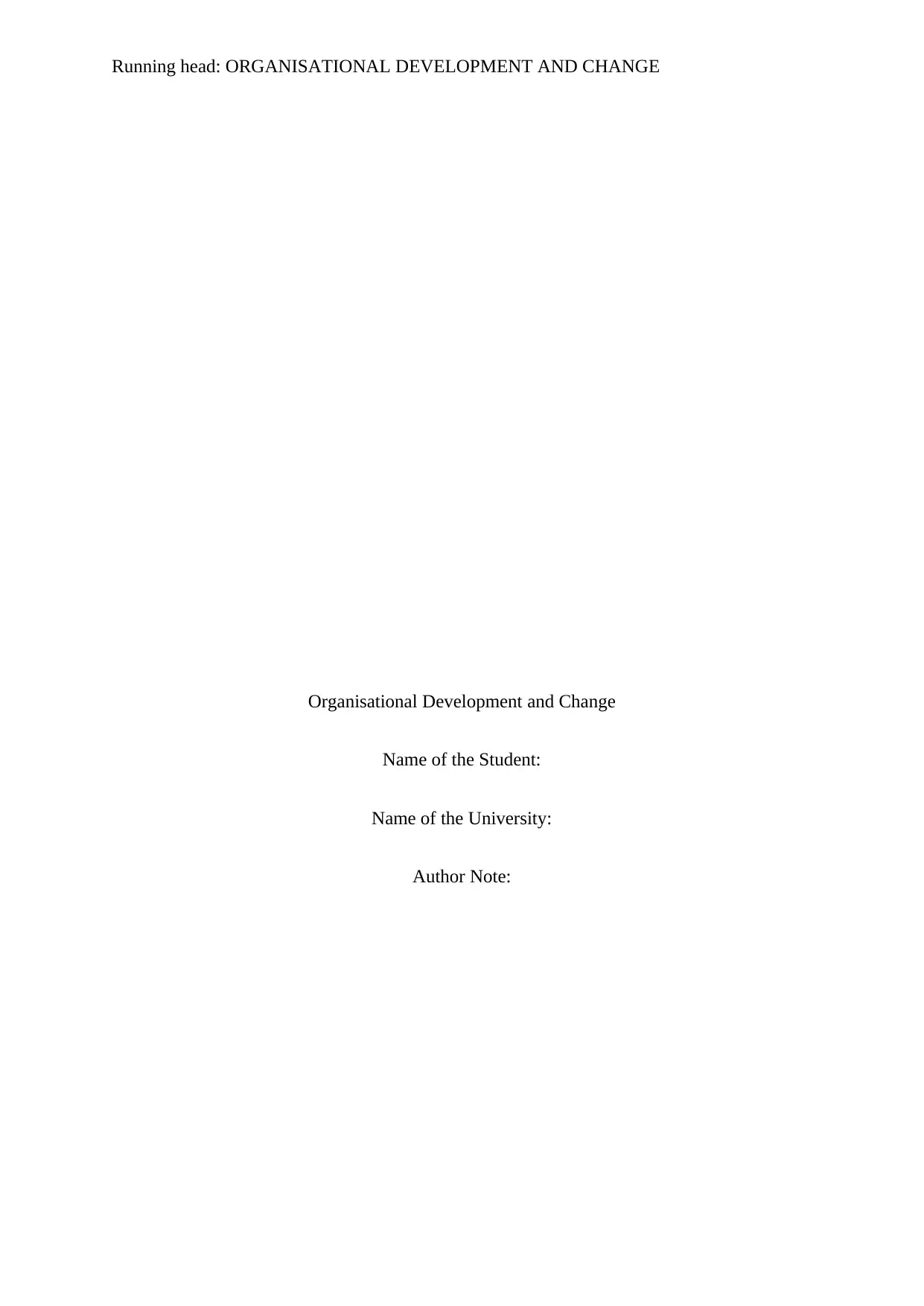
Running head: ORGANISATIONAL DEVELOPMENT AND CHANGE
Organisational Development and Change
Name of the Student:
Name of the University:
Author Note:
Organisational Development and Change
Name of the Student:
Name of the University:
Author Note:
Secure Best Marks with AI Grader
Need help grading? Try our AI Grader for instant feedback on your assignments.
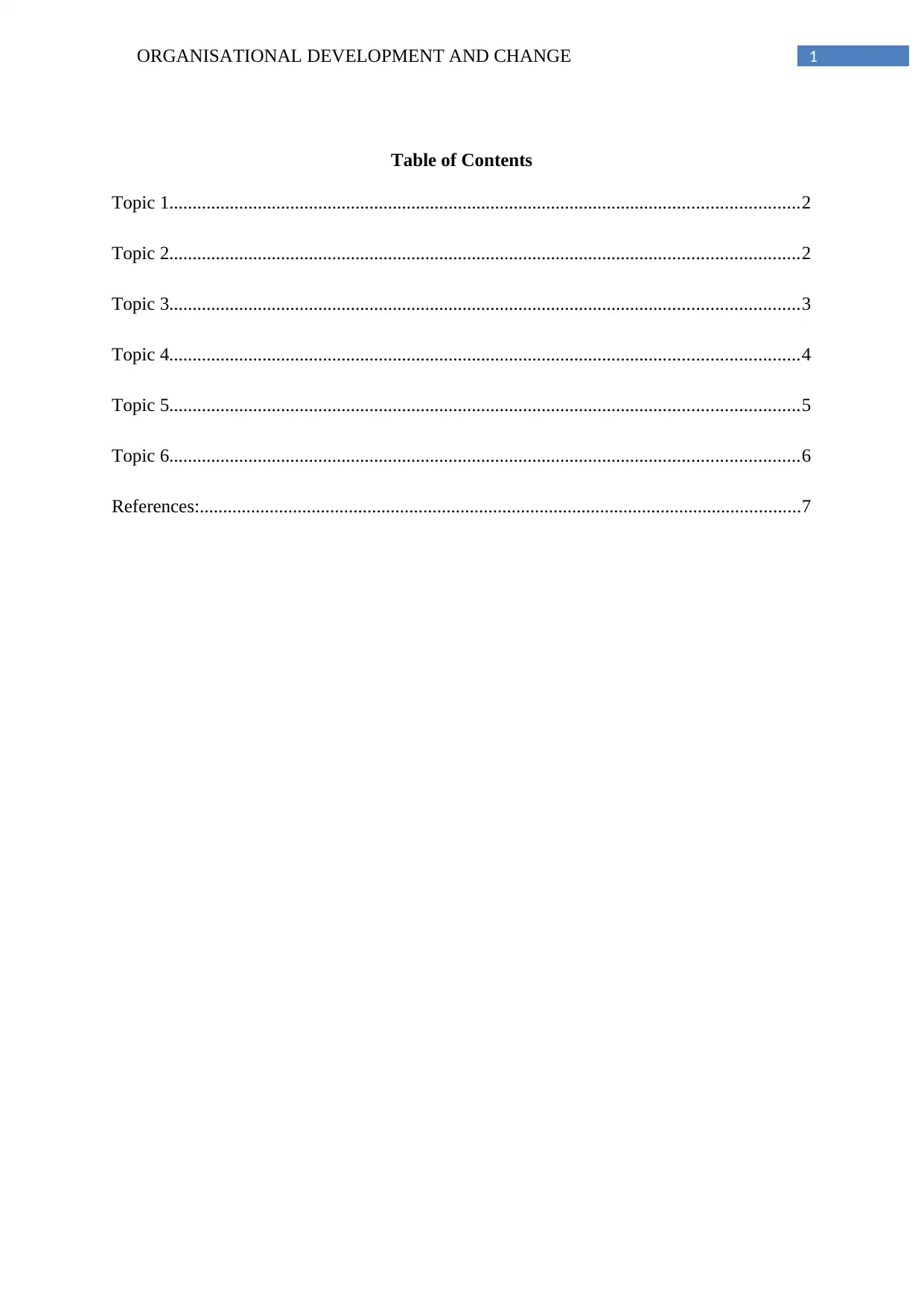
1ORGANISATIONAL DEVELOPMENT AND CHANGE
Table of Contents
Topic 1.......................................................................................................................................2
Topic 2.......................................................................................................................................2
Topic 3.......................................................................................................................................3
Topic 4.......................................................................................................................................4
Topic 5.......................................................................................................................................5
Topic 6.......................................................................................................................................6
References:.................................................................................................................................7
Table of Contents
Topic 1.......................................................................................................................................2
Topic 2.......................................................................................................................................2
Topic 3.......................................................................................................................................3
Topic 4.......................................................................................................................................4
Topic 5.......................................................................................................................................5
Topic 6.......................................................................................................................................6
References:.................................................................................................................................7
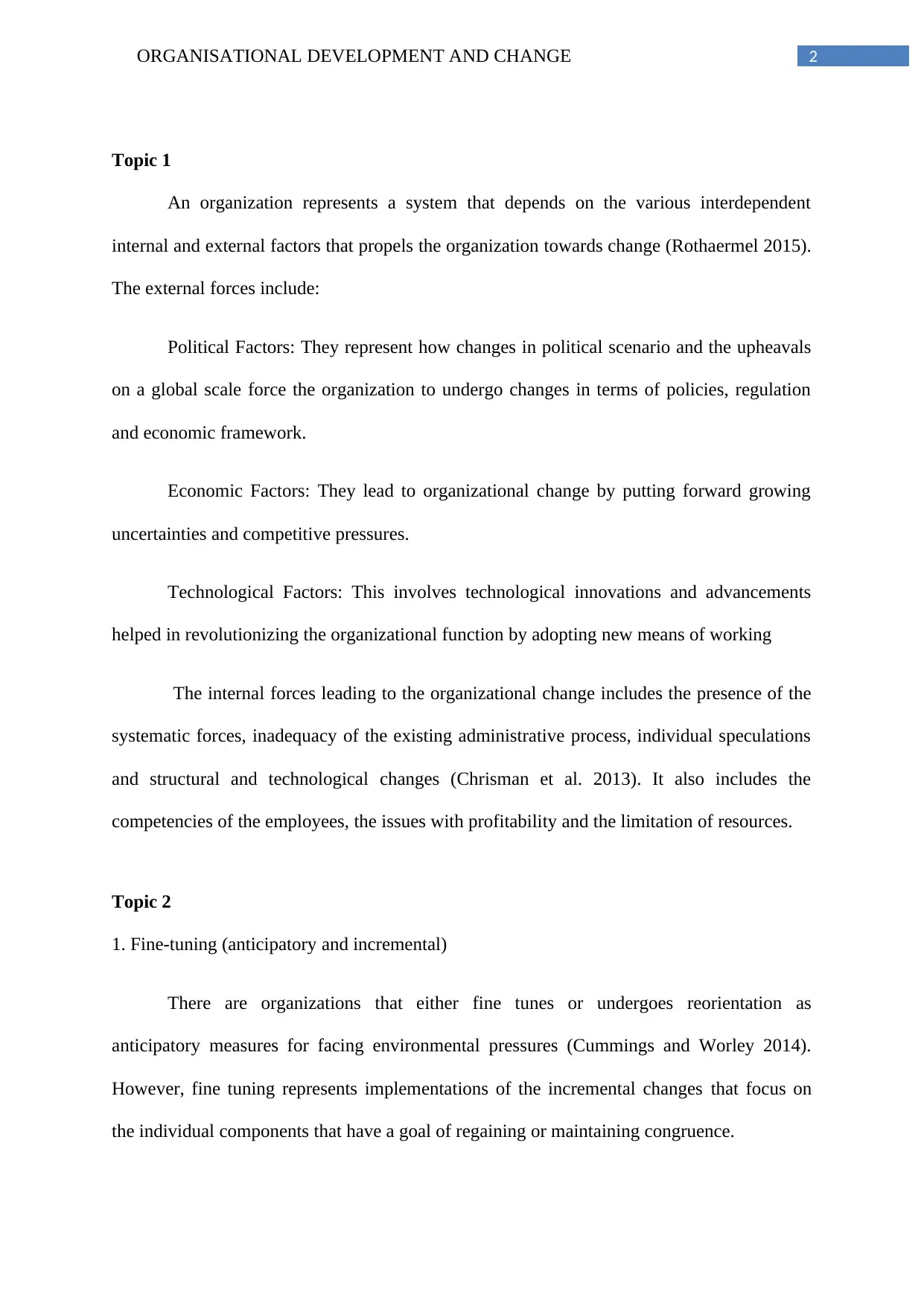
2ORGANISATIONAL DEVELOPMENT AND CHANGE
Topic 1
An organization represents a system that depends on the various interdependent
internal and external factors that propels the organization towards change (Rothaermel 2015).
The external forces include:
Political Factors: They represent how changes in political scenario and the upheavals
on a global scale force the organization to undergo changes in terms of policies, regulation
and economic framework.
Economic Factors: They lead to organizational change by putting forward growing
uncertainties and competitive pressures.
Technological Factors: This involves technological innovations and advancements
helped in revolutionizing the organizational function by adopting new means of working
The internal forces leading to the organizational change includes the presence of the
systematic forces, inadequacy of the existing administrative process, individual speculations
and structural and technological changes (Chrisman et al. 2013). It also includes the
competencies of the employees, the issues with profitability and the limitation of resources.
Topic 2
1. Fine-tuning (anticipatory and incremental)
There are organizations that either fine tunes or undergoes reorientation as
anticipatory measures for facing environmental pressures (Cummings and Worley 2014).
However, fine tuning represents implementations of the incremental changes that focus on
the individual components that have a goal of regaining or maintaining congruence.
Topic 1
An organization represents a system that depends on the various interdependent
internal and external factors that propels the organization towards change (Rothaermel 2015).
The external forces include:
Political Factors: They represent how changes in political scenario and the upheavals
on a global scale force the organization to undergo changes in terms of policies, regulation
and economic framework.
Economic Factors: They lead to organizational change by putting forward growing
uncertainties and competitive pressures.
Technological Factors: This involves technological innovations and advancements
helped in revolutionizing the organizational function by adopting new means of working
The internal forces leading to the organizational change includes the presence of the
systematic forces, inadequacy of the existing administrative process, individual speculations
and structural and technological changes (Chrisman et al. 2013). It also includes the
competencies of the employees, the issues with profitability and the limitation of resources.
Topic 2
1. Fine-tuning (anticipatory and incremental)
There are organizations that either fine tunes or undergoes reorientation as
anticipatory measures for facing environmental pressures (Cummings and Worley 2014).
However, fine tuning represents implementations of the incremental changes that focus on
the individual components that have a goal of regaining or maintaining congruence.
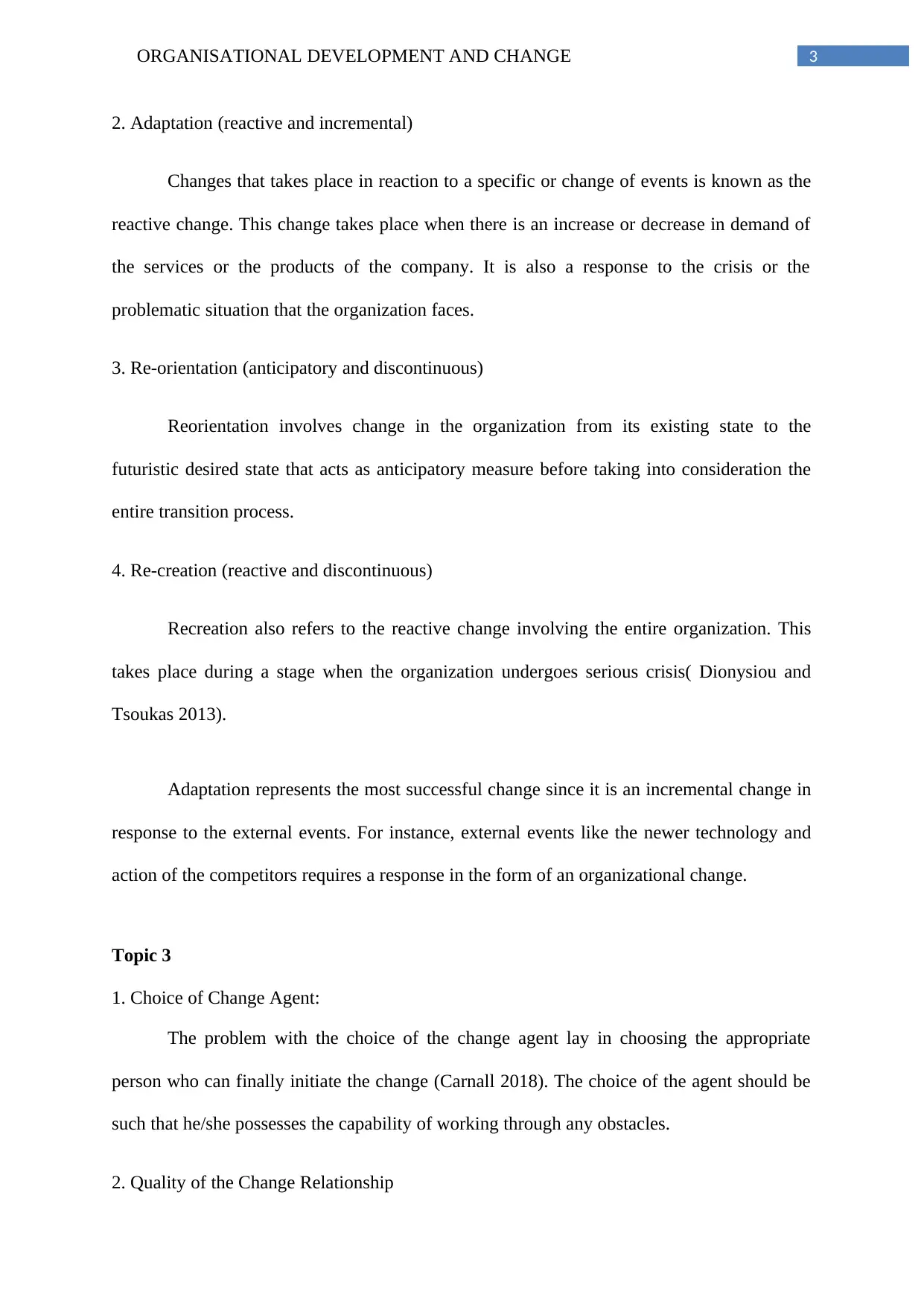
3ORGANISATIONAL DEVELOPMENT AND CHANGE
2. Adaptation (reactive and incremental)
Changes that takes place in reaction to a specific or change of events is known as the
reactive change. This change takes place when there is an increase or decrease in demand of
the services or the products of the company. It is also a response to the crisis or the
problematic situation that the organization faces.
3. Re-orientation (anticipatory and discontinuous)
Reorientation involves change in the organization from its existing state to the
futuristic desired state that acts as anticipatory measure before taking into consideration the
entire transition process.
4. Re-creation (reactive and discontinuous)
Recreation also refers to the reactive change involving the entire organization. This
takes place during a stage when the organization undergoes serious crisis( Dionysiou and
Tsoukas 2013).
Adaptation represents the most successful change since it is an incremental change in
response to the external events. For instance, external events like the newer technology and
action of the competitors requires a response in the form of an organizational change.
Topic 3
1. Choice of Change Agent:
The problem with the choice of the change agent lay in choosing the appropriate
person who can finally initiate the change (Carnall 2018). The choice of the agent should be
such that he/she possesses the capability of working through any obstacles.
2. Quality of the Change Relationship
2. Adaptation (reactive and incremental)
Changes that takes place in reaction to a specific or change of events is known as the
reactive change. This change takes place when there is an increase or decrease in demand of
the services or the products of the company. It is also a response to the crisis or the
problematic situation that the organization faces.
3. Re-orientation (anticipatory and discontinuous)
Reorientation involves change in the organization from its existing state to the
futuristic desired state that acts as anticipatory measure before taking into consideration the
entire transition process.
4. Re-creation (reactive and discontinuous)
Recreation also refers to the reactive change involving the entire organization. This
takes place during a stage when the organization undergoes serious crisis( Dionysiou and
Tsoukas 2013).
Adaptation represents the most successful change since it is an incremental change in
response to the external events. For instance, external events like the newer technology and
action of the competitors requires a response in the form of an organizational change.
Topic 3
1. Choice of Change Agent:
The problem with the choice of the change agent lay in choosing the appropriate
person who can finally initiate the change (Carnall 2018). The choice of the agent should be
such that he/she possesses the capability of working through any obstacles.
2. Quality of the Change Relationship
Secure Best Marks with AI Grader
Need help grading? Try our AI Grader for instant feedback on your assignments.
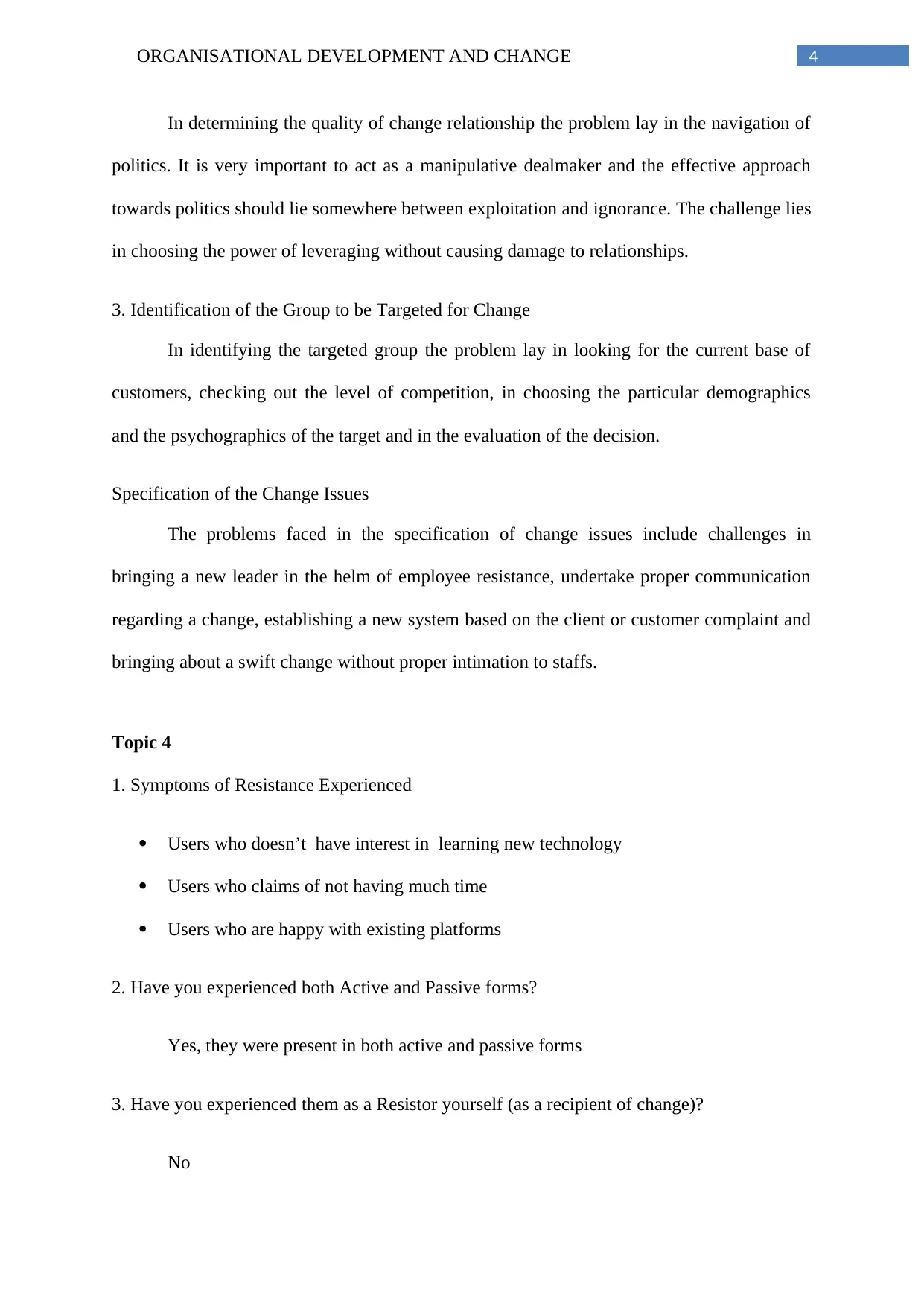
4ORGANISATIONAL DEVELOPMENT AND CHANGE
In determining the quality of change relationship the problem lay in the navigation of
politics. It is very important to act as a manipulative dealmaker and the effective approach
towards politics should lie somewhere between exploitation and ignorance. The challenge lies
in choosing the power of leveraging without causing damage to relationships.
3. Identification of the Group to be Targeted for Change
In identifying the targeted group the problem lay in looking for the current base of
customers, checking out the level of competition, in choosing the particular demographics
and the psychographics of the target and in the evaluation of the decision.
Specification of the Change Issues
The problems faced in the specification of change issues include challenges in
bringing a new leader in the helm of employee resistance, undertake proper communication
regarding a change, establishing a new system based on the client or customer complaint and
bringing about a swift change without proper intimation to staffs.
Topic 4
1. Symptoms of Resistance Experienced
Users who doesn’t have interest in learning new technology
Users who claims of not having much time
Users who are happy with existing platforms
2. Have you experienced both Active and Passive forms?
Yes, they were present in both active and passive forms
3. Have you experienced them as a Resistor yourself (as a recipient of change)?
No
In determining the quality of change relationship the problem lay in the navigation of
politics. It is very important to act as a manipulative dealmaker and the effective approach
towards politics should lie somewhere between exploitation and ignorance. The challenge lies
in choosing the power of leveraging without causing damage to relationships.
3. Identification of the Group to be Targeted for Change
In identifying the targeted group the problem lay in looking for the current base of
customers, checking out the level of competition, in choosing the particular demographics
and the psychographics of the target and in the evaluation of the decision.
Specification of the Change Issues
The problems faced in the specification of change issues include challenges in
bringing a new leader in the helm of employee resistance, undertake proper communication
regarding a change, establishing a new system based on the client or customer complaint and
bringing about a swift change without proper intimation to staffs.
Topic 4
1. Symptoms of Resistance Experienced
Users who doesn’t have interest in learning new technology
Users who claims of not having much time
Users who are happy with existing platforms
2. Have you experienced both Active and Passive forms?
Yes, they were present in both active and passive forms
3. Have you experienced them as a Resistor yourself (as a recipient of change)?
No
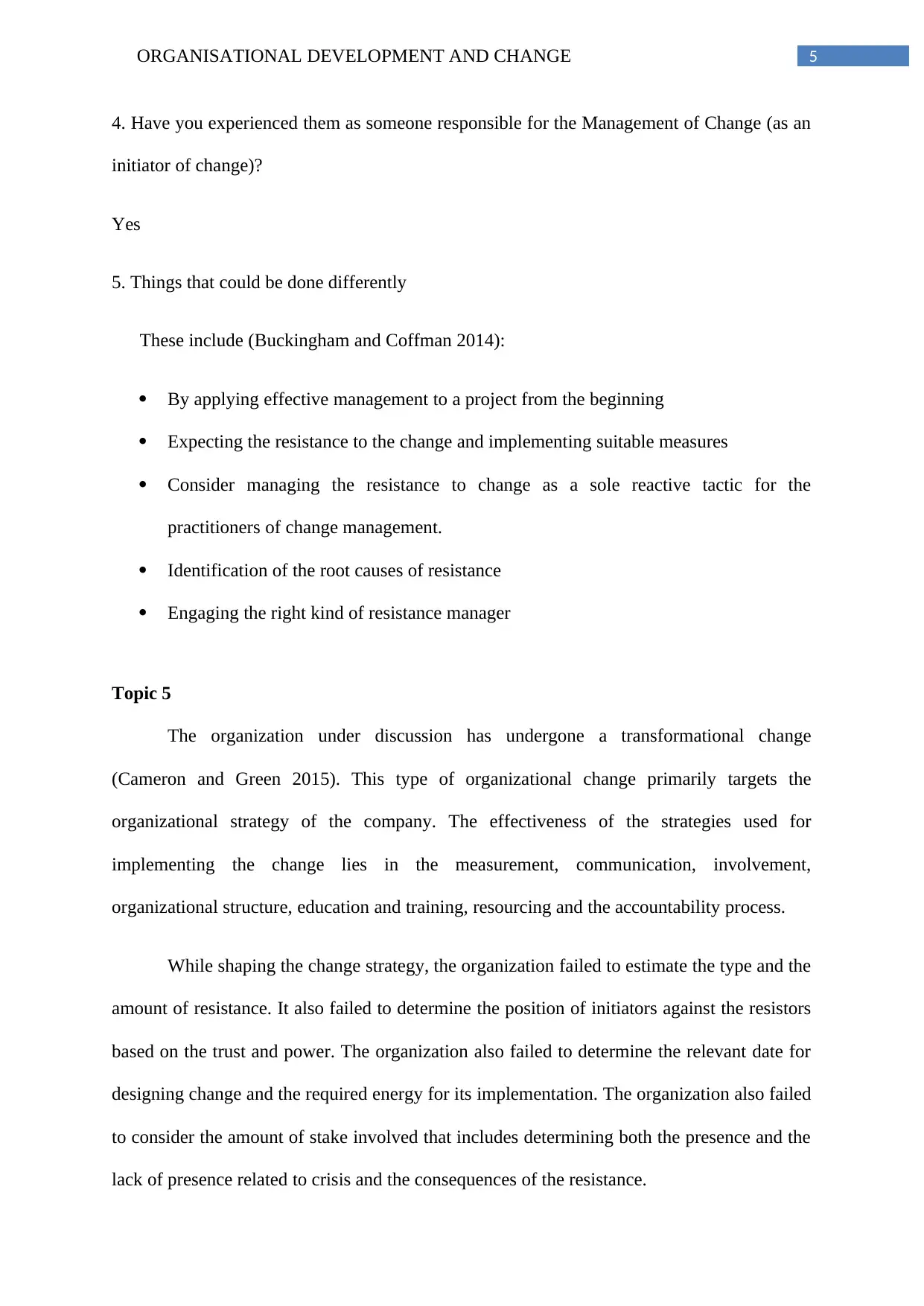
5ORGANISATIONAL DEVELOPMENT AND CHANGE
4. Have you experienced them as someone responsible for the Management of Change (as an
initiator of change)?
Yes
5. Things that could be done differently
These include (Buckingham and Coffman 2014):
By applying effective management to a project from the beginning
Expecting the resistance to the change and implementing suitable measures
Consider managing the resistance to change as a sole reactive tactic for the
practitioners of change management.
Identification of the root causes of resistance
Engaging the right kind of resistance manager
Topic 5
The organization under discussion has undergone a transformational change
(Cameron and Green 2015). This type of organizational change primarily targets the
organizational strategy of the company. The effectiveness of the strategies used for
implementing the change lies in the measurement, communication, involvement,
organizational structure, education and training, resourcing and the accountability process.
While shaping the change strategy, the organization failed to estimate the type and the
amount of resistance. It also failed to determine the position of initiators against the resistors
based on the trust and power. The organization also failed to determine the relevant date for
designing change and the required energy for its implementation. The organization also failed
to consider the amount of stake involved that includes determining both the presence and the
lack of presence related to crisis and the consequences of the resistance.
4. Have you experienced them as someone responsible for the Management of Change (as an
initiator of change)?
Yes
5. Things that could be done differently
These include (Buckingham and Coffman 2014):
By applying effective management to a project from the beginning
Expecting the resistance to the change and implementing suitable measures
Consider managing the resistance to change as a sole reactive tactic for the
practitioners of change management.
Identification of the root causes of resistance
Engaging the right kind of resistance manager
Topic 5
The organization under discussion has undergone a transformational change
(Cameron and Green 2015). This type of organizational change primarily targets the
organizational strategy of the company. The effectiveness of the strategies used for
implementing the change lies in the measurement, communication, involvement,
organizational structure, education and training, resourcing and the accountability process.
While shaping the change strategy, the organization failed to estimate the type and the
amount of resistance. It also failed to determine the position of initiators against the resistors
based on the trust and power. The organization also failed to determine the relevant date for
designing change and the required energy for its implementation. The organization also failed
to consider the amount of stake involved that includes determining both the presence and the
lack of presence related to crisis and the consequences of the resistance.
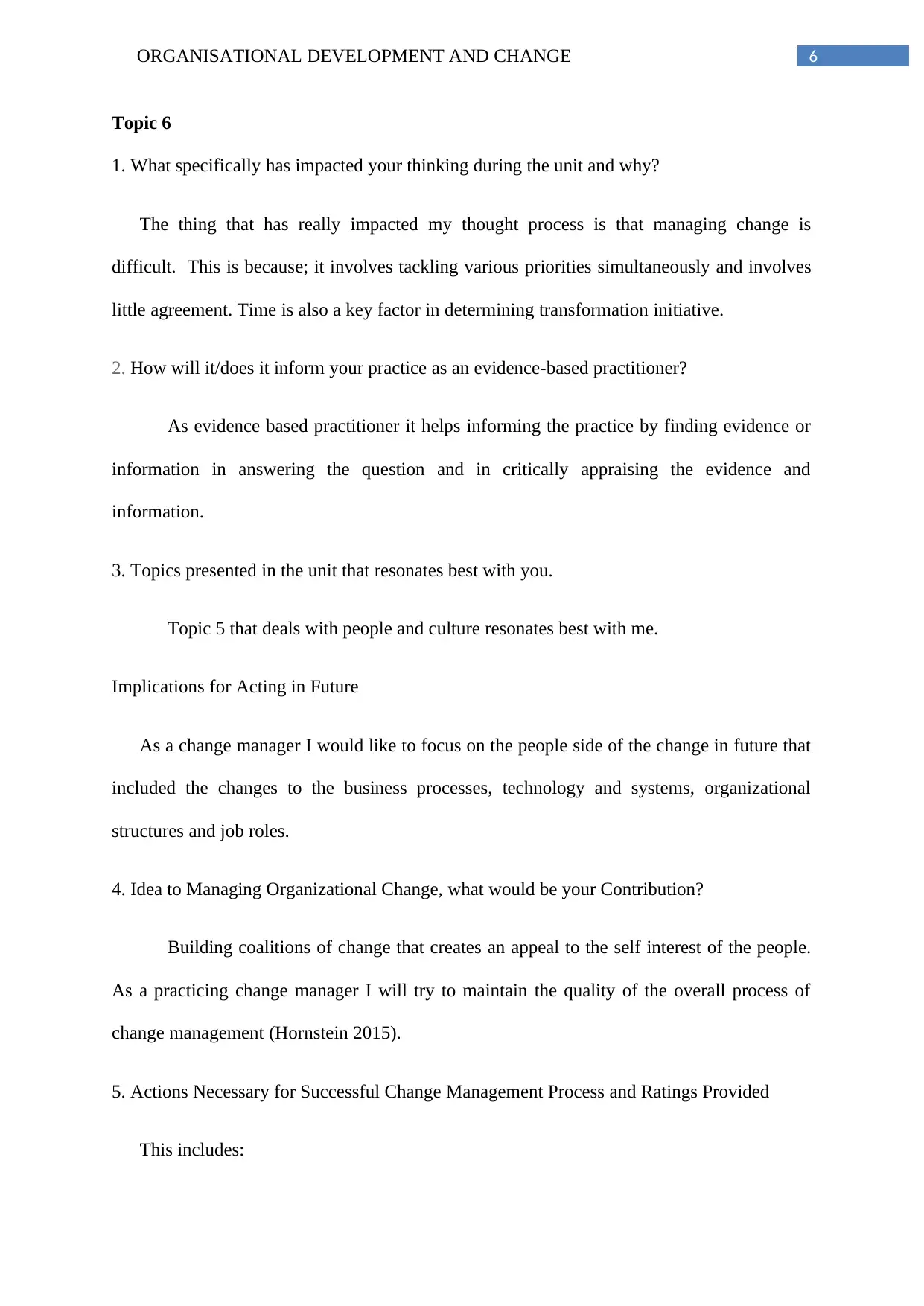
6ORGANISATIONAL DEVELOPMENT AND CHANGE
Topic 6
1. What specifically has impacted your thinking during the unit and why?
The thing that has really impacted my thought process is that managing change is
difficult. This is because; it involves tackling various priorities simultaneously and involves
little agreement. Time is also a key factor in determining transformation initiative.
2. How will it/does it inform your practice as an evidence-based practitioner?
As evidence based practitioner it helps informing the practice by finding evidence or
information in answering the question and in critically appraising the evidence and
information.
3. Topics presented in the unit that resonates best with you.
Topic 5 that deals with people and culture resonates best with me.
Implications for Acting in Future
As a change manager I would like to focus on the people side of the change in future that
included the changes to the business processes, technology and systems, organizational
structures and job roles.
4. Idea to Managing Organizational Change, what would be your Contribution?
Building coalitions of change that creates an appeal to the self interest of the people.
As a practicing change manager I will try to maintain the quality of the overall process of
change management (Hornstein 2015).
5. Actions Necessary for Successful Change Management Process and Ratings Provided
This includes:
Topic 6
1. What specifically has impacted your thinking during the unit and why?
The thing that has really impacted my thought process is that managing change is
difficult. This is because; it involves tackling various priorities simultaneously and involves
little agreement. Time is also a key factor in determining transformation initiative.
2. How will it/does it inform your practice as an evidence-based practitioner?
As evidence based practitioner it helps informing the practice by finding evidence or
information in answering the question and in critically appraising the evidence and
information.
3. Topics presented in the unit that resonates best with you.
Topic 5 that deals with people and culture resonates best with me.
Implications for Acting in Future
As a change manager I would like to focus on the people side of the change in future that
included the changes to the business processes, technology and systems, organizational
structures and job roles.
4. Idea to Managing Organizational Change, what would be your Contribution?
Building coalitions of change that creates an appeal to the self interest of the people.
As a practicing change manager I will try to maintain the quality of the overall process of
change management (Hornstein 2015).
5. Actions Necessary for Successful Change Management Process and Ratings Provided
This includes:
Paraphrase This Document
Need a fresh take? Get an instant paraphrase of this document with our AI Paraphraser
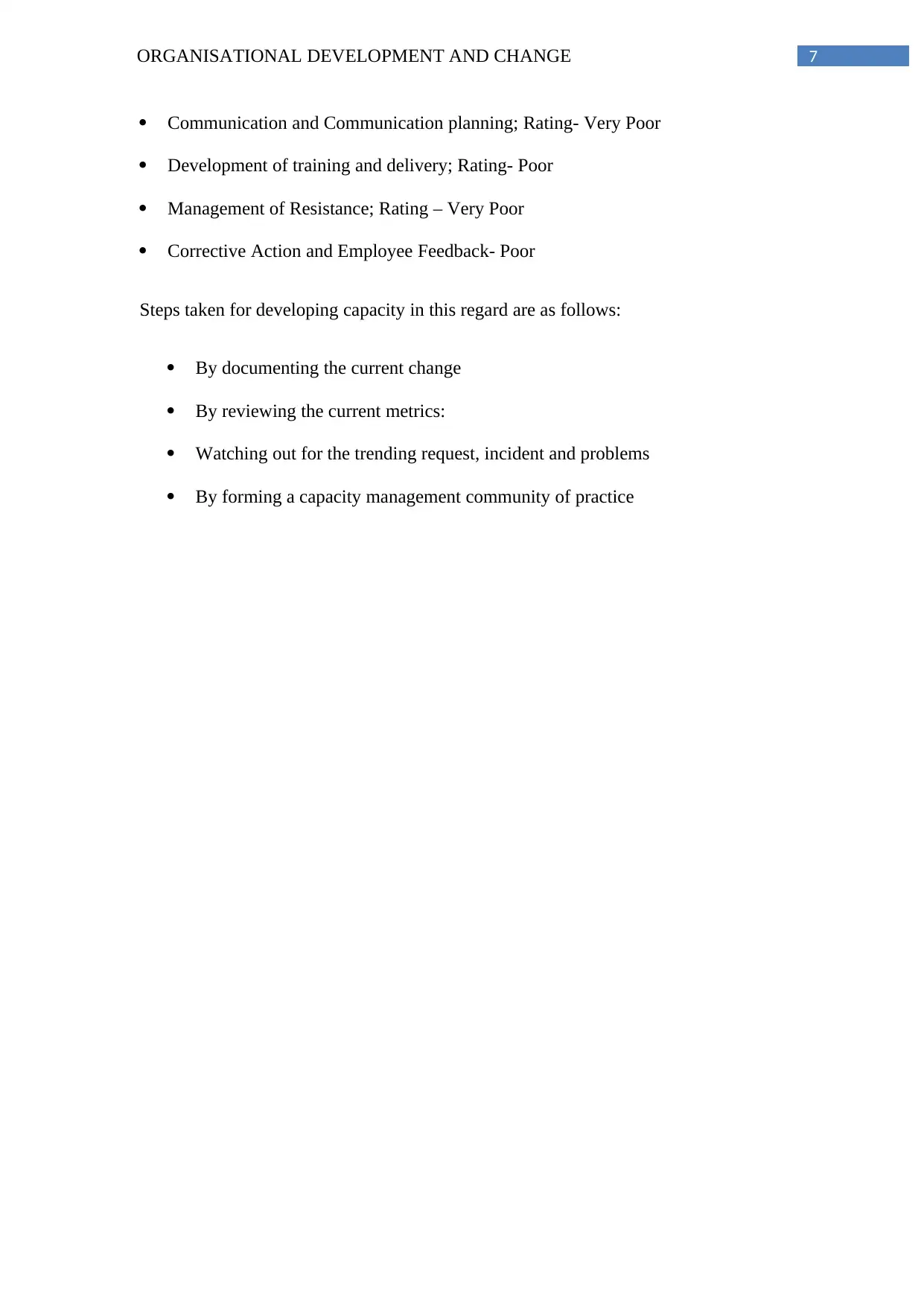
7ORGANISATIONAL DEVELOPMENT AND CHANGE
Communication and Communication planning; Rating- Very Poor
Development of training and delivery; Rating- Poor
Management of Resistance; Rating – Very Poor
Corrective Action and Employee Feedback- Poor
Steps taken for developing capacity in this regard are as follows:
By documenting the current change
By reviewing the current metrics:
Watching out for the trending request, incident and problems
By forming a capacity management community of practice
Communication and Communication planning; Rating- Very Poor
Development of training and delivery; Rating- Poor
Management of Resistance; Rating – Very Poor
Corrective Action and Employee Feedback- Poor
Steps taken for developing capacity in this regard are as follows:
By documenting the current change
By reviewing the current metrics:
Watching out for the trending request, incident and problems
By forming a capacity management community of practice
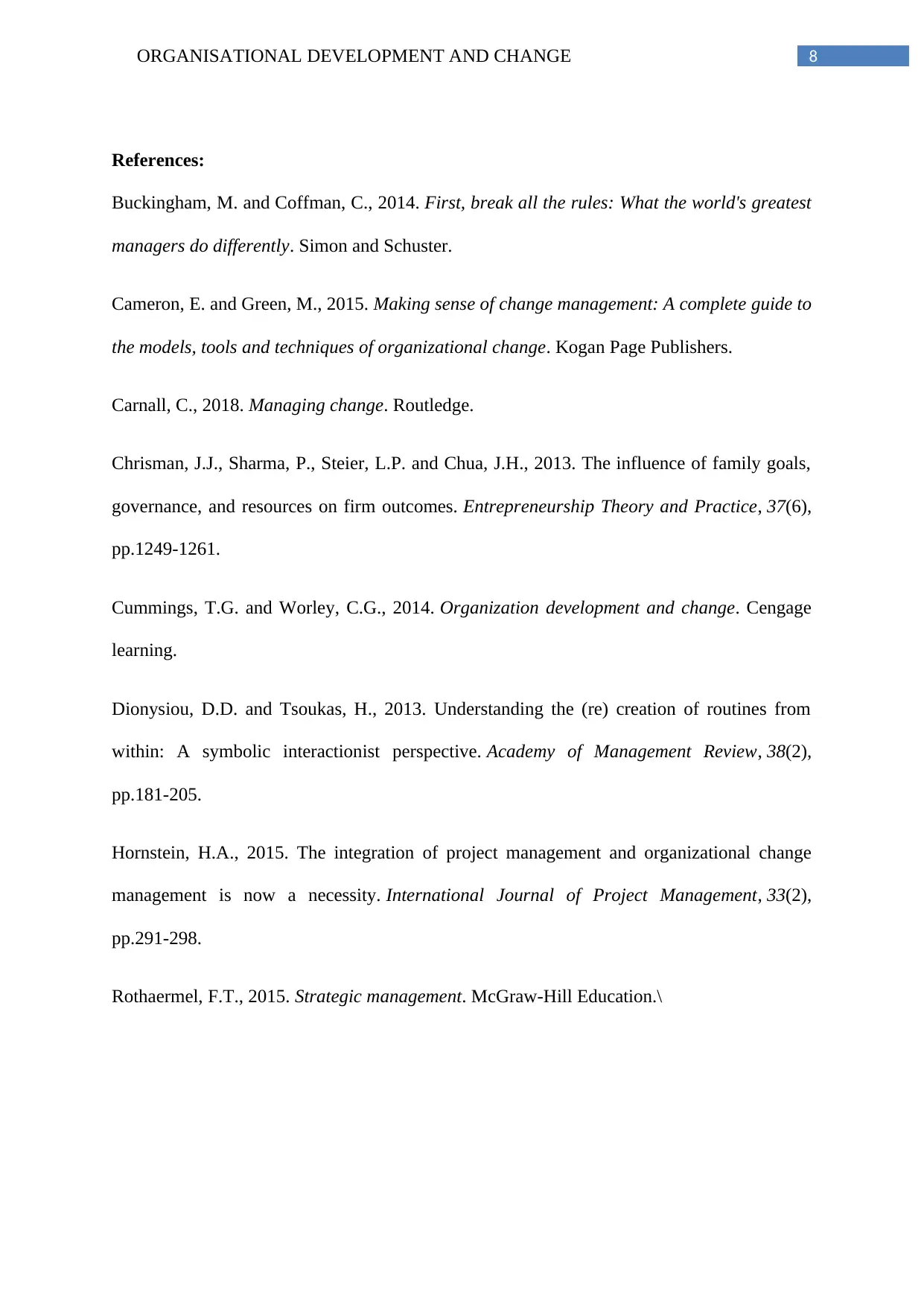
8ORGANISATIONAL DEVELOPMENT AND CHANGE
References:
Buckingham, M. and Coffman, C., 2014. First, break all the rules: What the world's greatest
managers do differently. Simon and Schuster.
Cameron, E. and Green, M., 2015. Making sense of change management: A complete guide to
the models, tools and techniques of organizational change. Kogan Page Publishers.
Carnall, C., 2018. Managing change. Routledge.
Chrisman, J.J., Sharma, P., Steier, L.P. and Chua, J.H., 2013. The influence of family goals,
governance, and resources on firm outcomes. Entrepreneurship Theory and Practice, 37(6),
pp.1249-1261.
Cummings, T.G. and Worley, C.G., 2014. Organization development and change. Cengage
learning.
Dionysiou, D.D. and Tsoukas, H., 2013. Understanding the (re) creation of routines from
within: A symbolic interactionist perspective. Academy of Management Review, 38(2),
pp.181-205.
Hornstein, H.A., 2015. The integration of project management and organizational change
management is now a necessity. International Journal of Project Management, 33(2),
pp.291-298.
Rothaermel, F.T., 2015. Strategic management. McGraw-Hill Education.\
References:
Buckingham, M. and Coffman, C., 2014. First, break all the rules: What the world's greatest
managers do differently. Simon and Schuster.
Cameron, E. and Green, M., 2015. Making sense of change management: A complete guide to
the models, tools and techniques of organizational change. Kogan Page Publishers.
Carnall, C., 2018. Managing change. Routledge.
Chrisman, J.J., Sharma, P., Steier, L.P. and Chua, J.H., 2013. The influence of family goals,
governance, and resources on firm outcomes. Entrepreneurship Theory and Practice, 37(6),
pp.1249-1261.
Cummings, T.G. and Worley, C.G., 2014. Organization development and change. Cengage
learning.
Dionysiou, D.D. and Tsoukas, H., 2013. Understanding the (re) creation of routines from
within: A symbolic interactionist perspective. Academy of Management Review, 38(2),
pp.181-205.
Hornstein, H.A., 2015. The integration of project management and organizational change
management is now a necessity. International Journal of Project Management, 33(2),
pp.291-298.
Rothaermel, F.T., 2015. Strategic management. McGraw-Hill Education.\
1 out of 9
Your All-in-One AI-Powered Toolkit for Academic Success.
+13062052269
info@desklib.com
Available 24*7 on WhatsApp / Email
![[object Object]](/_next/static/media/star-bottom.7253800d.svg)
Unlock your academic potential
© 2024 | Zucol Services PVT LTD | All rights reserved.
